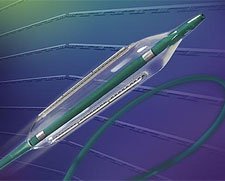
Categorised under:
Cardio-thoracic
>
Coronary intervention
>
Balloons
Interventional Radiology
>
Vascular
>
Fistulaplasty
The flextome represents the third generation cutting balloon approved for use in coronary lesions. This balloon consists of 3 cutting tomes attached circumferentially at an angle of 60 degrees to a non compliant balloon. The balloon is used for lesion preparation in challenging cases prior to stent deployment eg calcified vessel, ostial disease, bifurcations, restenosis. In theory inflation of the device leads to a controlled dissection plane along the tomes as opposed to the "uncontrolled" dissection that can occur following dilation with a standard balloon.
The flextome represents the third generation cutting balloon approved for use in coronary lesions. This balloon consists of 3 cutting tomes attached circumferentially at an angle of 60 degrees to a non compliant balloon. The balloon is used for lesion preparation in challenging cases prior to stent deployment eg calcified vessel, ostial disease, bifurcations, restenosis. In theory inflation of the device leads to a controlled dissection plane along the tomes as opposed to the “uncontrolled” dissection that can occur following dilation with a standard balloon.
In terms of deliverability it is significantly improved from the previous Ultra II version. There are two major differences that make it more deliverable:
The enhanced deliverability and smaller crossing profile are immediately noticeable on first use when compared to the Ultra II and its performance at the target site does not appear to have been compromised by the improved design. Whilst the first version had problems with unstable tomes and possible disintegration that led to its withdrawal, the latest version claims to have resolved these initial problems. We are a large volume department (performing >2800 PCI’s per annum) and our use of cutting ballons is over 100 per year. Since the flextomes were reintroduced to clinical practice mid 2009, we have had one experience of the blades dislocating from the balloon after inflation.
In terms of crossing profile and deliverability, the flextome represents a quantum leap from the previous Ultra II cutting balloon. Thankfully, its efficacy remains unaffected. However, before its widespread use can be recommended, quality control issues need to be addressed as a matter of urgency.
Dr Azfar Zaman, Consultant Cardiologist, Freeman Hospital, Newcastle upon Tyne, UK
No conflict declared

Did you know you can Register for FREE with this website?
Registration gives you full access to all of the features of WhichMedicalDevice. Find out more ...
WhichMedicalDevice is a FREE resource created by clinicians for clinicians.
Registration is free and gives you unlimited access to all of the content and features of this website.
Find out more...Registration is free and gives you unlimited access to all of the content and features of Which Medical Device. Find out more...
Which Medical Device is a community of clinicians sharing knowledge and experience of the devices and procedures we use on a daily basis. We ask that our members register with us so that we can maintain the unbiased and independent nature of our content. Registration is quick and free.
We do not make your details available to any third parties nor do we send unsolicited emails to our members. You can read our Privacy Policy here.